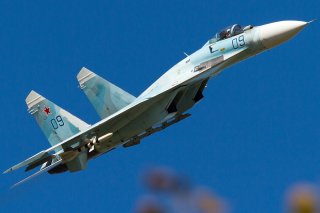Why Russia's Su-27 Fighter Is Still a Gamechanger
Like many interesting Soviet tanks, aircraft, and weapons designs, steady incremental improvements to the initial airplane have greatly extended its service life.
Sukhoi, one of the Soviet Union’s premier aviation groups, built many noteworthy and impressive jets for the USSR in the twentieth century, and today does the same for Russia. One of the most successful designs is the Su-27.
High-low Mix
The Su-27 is a Soviet-era airplane that functioned as part of the USSR’s high-low mix air combat theory. Operationalized, this means that a large number of somewhat small and lower performance aircraft fly with a smaller number of highly capable, high-end jet fighters.
This team is a force multiplier and allows a smaller number of aircraft to be more capable against a numerically superior opponent. In addition, the Su-27 was intended to keep an eye on the Soviet Union’s borders as a long-range air superiority fighter, patrolling for NATO bomber sorties.
Given the Su-27’s long combat range, the airplane could also serve as an escort fighter for Soviet long-range bombers like the Tu-160 “Blackjack,” Tu-22M “Backfire,” and Tu-95 “Bear” Cold War-era airplanes that are still in service today.
Speedy and Agile
The Su-27 is highly agile thanks to its super maneuverability, an agility grouping that only a few airplanes are capable of. For example, the Su-27 can perform Pugachev’s Cobra, a super maneuver in which an aircraft flying at low-to-moderate speed quickly raises its nose. Then, the airframe acts as a large airbrake, rapidly decelerates, lowers its nose, and accelerates away.
Long Past Retirement
Like many interesting Soviet tanks, aircraft, and weapons designs, steady, incremental improvements to the initial airplane have greatly extended its service life.
There are an astounding number of Su-27 variants that have flown for the Soviet Union, Russia, and for other customers abroad. This class of airplanes, the Flanker family of aircraft, are improvements over the basic, original Su-27 design that offer improved avionics, extended ranges, and other additional enhancements.
And therein lies the Su-27’s continued success as a proficient and highly agile airframe that has steadily incorporated incremental improvements as technology improves and becomes more widely available. This is reflected in the airplane’s continued service today—the Flanker family of airplanes is flown within former Warsaw Pact countries as well as in various Middle Eastern, Latin American, and African countries.
Although stealth is now king, the Su-27 probably will not go away and out of service anytime soon. Against opponents that lack robust air defenses or any kind of air force, the Su-27 could still excel. However, when flying against stealth aircraft or against an opponent with a robust anti-aircraft capability, the airplane would struggle.
Caleb Larson is a multimedia journalist and defense writer with the National Interest. A graduate of UCLA, he also holds a Master of Public Policy and lives in Berlin. He covers the intersection of conflict, security, and technology, focusing on American foreign policy, European security, and German society for both print and radio. Follow him on Twitter @calebmlarson
Image: Wikimedia Commons.

